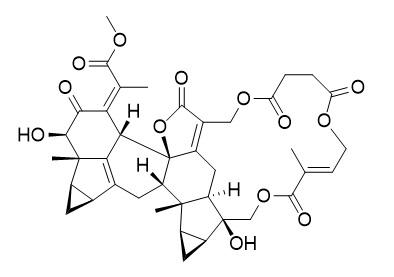Shizukaol B
Shizukaol B exerts anti-inflammatory effects in LPS-activated microglia partly by modulating JNK-AP-1 signaling pathway; it also
shows significant anti-neuroinflammatory effects by inhibiting nitric-oxide (NO) production in lipopolysaccharide (LPS)-stimulated murine BV-2 microglial cells with relatively low cytotoxicity. Shizukaol B exhibits anti-HIV-1 replication activities in both wild-type HIV-1 and two NNRTIs-resistant strains, it also has significant cytotoxicities against C8166 cells. Shizukaol B prevents monocyte adhesion to HUVEC through the inhibition of cell adhesion molecules expression stimulated by TNF-alpha.
Inquire / Order:
manager@chemfaces.com
Technical Inquiries:
service@chemfaces.com
Tel:
+86-27-84237783
Fax:
+86-27-84254680
Address:
1 Building, No. 83, CheCheng Rd., Wuhan Economic and Technological Development Zone, Wuhan, Hubei 430056, PRC
Providing storage is as stated on the product vial and the vial is kept tightly sealed, the product can be stored for up to
24 months(2-8C).
Wherever possible, you should prepare and use solutions on the same day. However, if you need to make up stock solutions in advance, we recommend that you store the solution as aliquots in tightly sealed vials at -20C. Generally, these will be useable for up to two weeks. Before use, and prior to opening the vial we recommend that you allow your product to equilibrate to room temperature for at least 1 hour.
Need more advice on solubility, usage and handling? Please email to: service@chemfaces.com
The packaging of the product may have turned upside down during transportation, resulting in the natural compounds adhering to the neck or cap of the vial. take the vial out of its packaging and gently shake to let the compounds fall to the bottom of the vial. for liquid products, centrifuge at 200-500 RPM to gather the liquid at the bottom of the vial. try to avoid loss or contamination during handling.
Life (Basel).2022, 12(12):2107.
Pharm Biol.2017, 55(1):360-366
Chem Res Toxicol. 2022, acs.chemrestox.2c00049.
Emirates Journal of Food and Agriculture.2022, 34(6): 528-536.
Am J Chin Med.2022, 1-20.
Molecules.2022, 27(4):1412.
J Food Compos Anal2017, 62:197-204
Antioxidants (Basel).2020, 9(6):466.
J Neuroinflammation.2020, 17(1):75.
Pharmaceutics.2020, 12(9):845.
Related and Featured Products
Biomed Pharmacother. 2017 Apr;88:878-884
Shizukaol B, an active sesquiterpene from Chloranthus henryi, attenuates LPS-induced inflammatory responses in BV2 microglial cells.[Pubmed:
28178617 ]
The objective of the current study was to evaluate the anti-inflammatory effects of Shizukaol B, a lindenane-type dimeric sesquiterpene isolated from the whole plant of Chloranthus henryi, on lipopolysaccharide (LPS)-induced activation of BV2 microglial cells in vitro.
METHODS AND RESULTS:
Our data showed that Shizukaol B concentration-dependently suppressed expression of inducible nitric oxide synthase (iNOS) and cyclooxygenase-2 (COX-2), production of nitric oxide (NO), tumor necrosis factor-α (TNF-α), and interleukin-1β (IL-1β) in LPS-stimulated BV2 microglia. Meanwhile, Shizukaol B concentration- and time-dependently inhibited LPS-mediated c-Jun N-terminal kinase 1/2 (JNK) activation, but had little effect on extracellular signal-regulated kinase 1/2 or p38 phosphorylation. Furthermore, Shizukaol B significantly blocked LPS-induced activator protein-1 (AP-1) activation, evidenced by reduced phosphorylation and nuclear translocation of c-Jun and DNA binding activity of AP-1.
CONCLUSIONS:
Taken together, our findings suggest that Shizukaol B exerts anti-inflammatory effects in LPS-activated microglia partly by modulating JNK-AP-1 signaling pathway.
Chem Biodivers. 2014 Jun;11(6):919-28.
Sesquiterpenoids from Chloranthus henryi and their anti-neuroinflammatory activities.[Pubmed:
24934677 ]
METHODS AND RESULTS:
Five new and seven known mono-sesquiterpenoids (1-5 and 6-12, resp.) together with five known lindenane-type disesquiterpenoids, 13-17, were isolated from the whole plant of Chloranthus henryi. Based on spectroscopic methods, the new structures were established to be (5S,6R,8S,10R)-6-hydroxyeudesma-4(15),7(11)-diene-12,8-olide (1), 6α-hydroxyeudesma-4(15),7(11),8(9)-triene-12,8-olide (2), 8,12-epoxy-1β-hydroxyeudesma-4(15),7,11-trien-6-one (3), 12-oxochloraniolide A (4), and (4α)-8-hydroxy-12-norcardina-6,8,10-trien-11-one (5), respectively.
CONCLUSIONS:
Among the isolates, compound 2, zederone epoxide (8), spicachlorantin G (13), chloramultilide A (14), Shizukaol B (15), and spicachlorantin B (17) showed significant anti-neuroinflammatory effects by inhibiting nitric-oxide (NO) production in lipopolysaccharide (LPS)-stimulated murine BV-2 microglial cells with relatively low cytotoxicity.
J Nat Prod. 2011 Jun 24;74(6):1408-13
Lindenane disesquiterpenoids with anti-HIV-1 activity from Chloranthus japonicus.[Pubmed:
21650224]
Five new lindenane disesquiterpenoids, chlorajaponilides A-E (1-5), together with 11 known analogues were isolated from whole plants of Chloranthus japonicus.
METHODS AND RESULTS:
The structure and absolute configuration of 1 was confirmed by X-ray crystallography. Compounds 1 and 2 represent the first examples of lindenane disesquiterpenoids with a C-5 hydroxy group and a C-4-C-15 double bond. Compounds 8, 9, 11, and 12 showed anti-HIV-1 replication activities in both wild-type HIV-1 and two NNRTIs-resistant strains. Shizukaol B (8) exhibited the best activity against HIV(wt), HIV(RT-K103N), and HIV(RT-K103N) with EC₅₀ values of 0.22, 0.47, and 0.50 μM, respectively.
Compounds 8, 9, 11, and 12 had significant cytotoxicities against C8166 cells with CC₅₀ values of 0.020, 0.089, 0.047, and 0.022, respectively, and exhibited inhibitory activities against HIV-1 with EC₅₀ values of 0.0014, 0.016, 0.0043, and 0.0033 μM, respectively.
J Ethnopharmacol. 2006 Mar 8;104(1-2):270-7.
Dimeric sesquiterpenoids isolated from Chloranthus japonicus inhibited the expression of cell adhesion molecules.[Pubmed:
16229979 ]
In the search for cell adhesion inhibitors from natural sources, three active compounds were isolated from Chloranthus japonicus Sieb. (Chloranthaceae) roots. The compounds were identified as dimeric sesquiterpenoids of Shizukaol B (1), cycloshizukaol A (2) and shizukaol F (3).
METHODS AND RESULTS:
These compounds inhibited PMA-induced homotypic aggregation of HL-60 cells without cytotoxicity with MIC values of 34.1 nM (1), 0.9 microM (2) and 27.3 nM (3), respectively. Although 1-3 did not affect the direct binding of LFA-1 to ICAM-1, these compounds markedly inhibited ICAM-1 expression in HL-60 cells in a dose-dependent fashion. On the other hand, when HUVEC were pretreated with 1-3 and stimulated with TNF-alpha, adhesion of THP-1 cells to HUVEC decreased in dose-dependent manner with IC(50) values of 54.6 nM, 1.2 microM and 34.1 nM, respectively. In fact, 1 inhibited TNF-alpha-induced surface expression of the ICAM-1, VCAM-1 and E-selectin in HUVEC with IC(50) values of 5.4 nM, 13.6 microM and 95.6 nM, respectively.
CONCLUSIONS:
The present findings suggest that 1-3 prevent monocyte adhesion to HUVEC through the inhibition of cell adhesion molecules expression stimulated by TNF-alpha.



